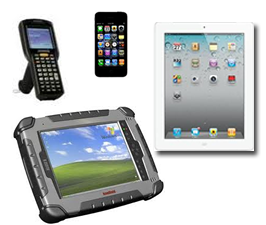
From basic scanners for scanning inventory in a grocery store to fork-lift mounted terminals for warehouse operations to drop-proof notebooks for construction workers, mobile devices have been around for several decades.
However, the “rugged” device industry is in turmoil thanks to the proliferation of smartphones and tablets and the BYOD (bring your own device) siege at most companies. Up until just a few years ago, the rugged terminals (think Symbol, Telxon, Intermec) were in a different class of devices than the smartphone and pretty much left alone when it comes to a purchasing decision for a device used in operations. Today, the lines are blurred in a big way.
As companies hit the refresh cycle on existing rugged equipment, many business are stepping back and reviewing the function of the device through a new lens. For example, Lowe’s recently decided to deploy 42,000 iPhones (read the full article) to help the company become more consumer centric by blending technology used in the store (by associates) and that of its customers. From a content and utility standpoint, the Lowe’s decision is pretty smart as much of the Lowe’s DIY (do it yourself) content is great for in-store customer service as well as service after the sale. It’s all the same information. And, like the device Apple uses in its own Apple Store, Lowe’s associates can check out customers on the fly without having to wait in line.
Look out rugged device manufacturers
While the smartphones and tablets do have limitations for retail and industrial use, third party vendors are helping to close this gap. Smartphones may not be designed for high volume scanning, or credit card processing, but Infinite Peripherals offers an elegant solution. Both the Apple Store and Lowe’s use the “wrapper” device called the Linea-Pro. The device wraps an iPhone or iPod Touch and attaches a bar code scanner (optional) and credit card reader, along with an extended battery. The wrapper is compact and based my experience at several Apple Stores and some hands-on testing, the device works great. A similar product for the Android does not, to my knowledge, exist just yet, but it will soon. The main issue holding Android back is the hardware variances between Android devices manufacturers – the connection port varies in format and location, even across devices from the same manufacturer (standards anyone?).
Another threat is Square. This little device simply plugs in to the bottom of your iPhone, iPod Touch or iPad and allows retailers to swipe customer credit cards, capture signatures and process payments. Several other add-on devices of this nature are being announced this week at the Consumer Electronics Show in Las Vegas.
Regardless of the “rugged” shortcomings of consumer smartphones and tablets, the decision is no longer apples and oranges. For one, not all jobs need a rugged device. In the past, there were few options. Today, smartphones win hands-down due to market penetration. There are roughly 161 million smartphones, mostly Apple and Android, in the U.S. alone. Along with this reach is the plethora of new development tools and developers that make writing mobile applications much easier than the past. And, while your smartphone may not be drop proof, there are a number of vendors now providing rugged covers for nearly every flavor of smartphone and tablet. Griffin Technology and Otterbox are two that come to mind.
Hold on
Before you think this post is all about new technology, the term “rugged” is more than surviving a drop to a hard surface. For example, the iPad operational temperature limits are 32F to 95F. Try leaving yours in the sun for a bit while on the beach or posting up outside on the slopes and you will soon understand how quickly temperature can have an impact.
Obviously there are many other factors, but the scope of which depends on your business objective. That take us to the business case: rugged vs smartphone.
The Business case
Before you sell your boss on the benefits of a smartphone (or rugged terminal), you might want to make sure your business case is grounded with facts and is aligned to your operational needs.
For example, a smartphone may be half the cost of a rugged terminal, but the life expectancy for each device will be different. The life span of a smartphone is probably three years compared to a rugged terminal that might last six or more. I’ve seen instances where 15 year old terminals are still in operation. You will have a hard time beating that business case if looking from a pure financial perspective.
With the capability of “doing more” on a smartphone you should account for the added software development and maintenance costs, as well as any impact to support. And, do not forget about how all the new features will connect and work with your back-end technology environment. Very rarely in my 24 years of doing mobile have I seen the mobile initiative plug-in seamlessly to the back-end. Just saying…
With the whole BYOD model, a new set of security and other worries come into play. These like many other obstacles are not insurmountable, but rather need to be articulated so the business can make an informed decision. As an example, we recently helped a large retailer avoid $25 million in operations cost on a mobile project just by looking at things a bit differently and laying out the various scenarios to help them marry the right mobile strategy to their operational objectives.
Going forward, I believe we will see more and more consumer technology used where was once a rugged device. It would be nice to see Intermec and the other established players in the industrial space create peripherals and accessories like the Linea-Pro to speed-up and improve the use of smartphones and tablets for business applications. Time will tell.






